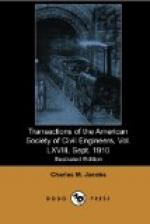The concrete lining was introduced to insure the permanency of the structure, strengthen it from outward pressure and guard it against injury from accidents which might occur in the tunnel. The side concrete benches were suggested by Mr. Cassatt, President, to confine the trains to the center of the tunnels in case of derailment, and to furnish sidewalks on each side of the trains so as to obviate the necessity of walking on the track.
Refuge niches are constructed in the side benches of the tunnels. Manholes, splicing chambers, pump chambers, and other features for the handling of the electric cables and drainage, are established at intervals.
At points where unusual stresses were anticipated, as for instance where the tunnels pass from rock to soft ground, the shell was composed of steel instead of cast-iron plates. In the North River tunnels the concrete lining in the invert and in the arch was reinforced by longitudinal steel bars, but these were not introduced in the East River tunnels.
Other details connected with the structures, including the drainage, lighting, ventilation, signaling, and electrification systems, will be given in succeeding papers.
Stability of the Sub-River Tunnels.—One of the most important questions connected with the design of these tunnels was their probable stability under the long-continued action of a heavy and rapid railroad traffic. The tunnels are lighter than the materials which they displace even when the weight of the heavy live load is included. In the East River the character of the material seemed to justify the conclusion that the tunnels would not be displaced even under the action of the live load. In the North River, however, the tunnels are enveloped by a soft silt and it was at first apprehended that some system of supports would be advisable to carry the heavy traffic and insure the tunnels against displacement under its action. To meet this contingency, which was then believed to be a very serious one, it was proposed to sink cast-iron screw-piles through the bottom of each tunnel into and through the underlying




